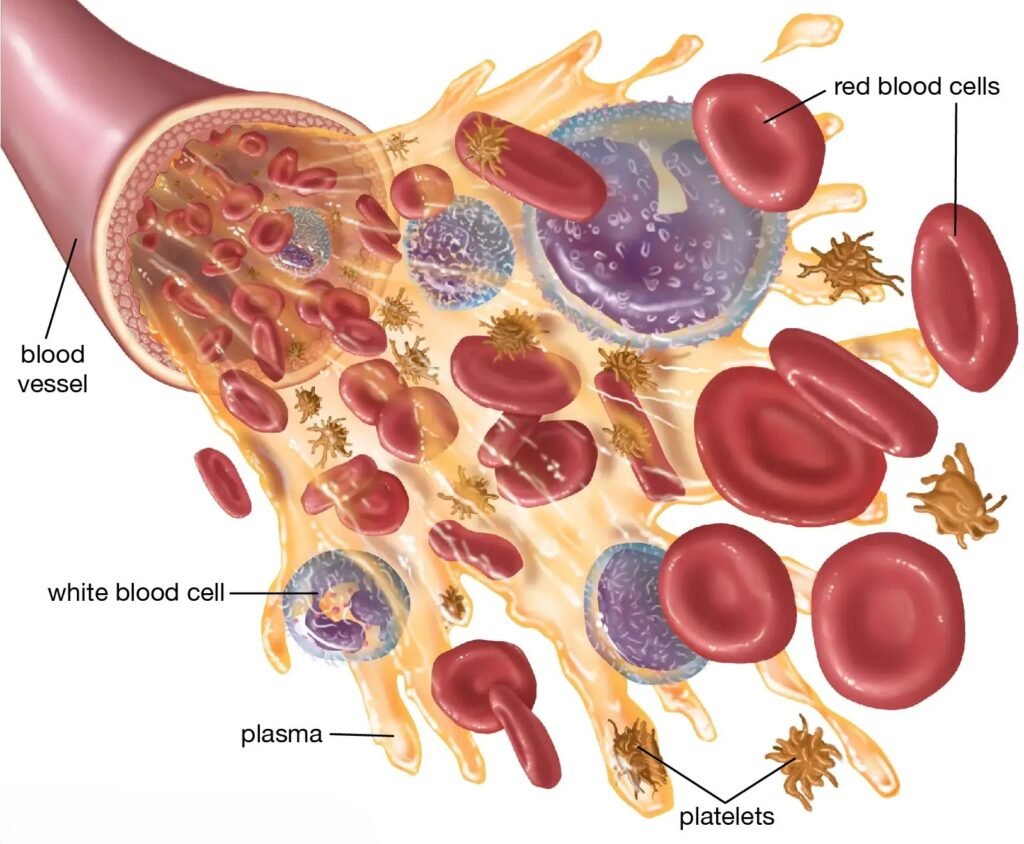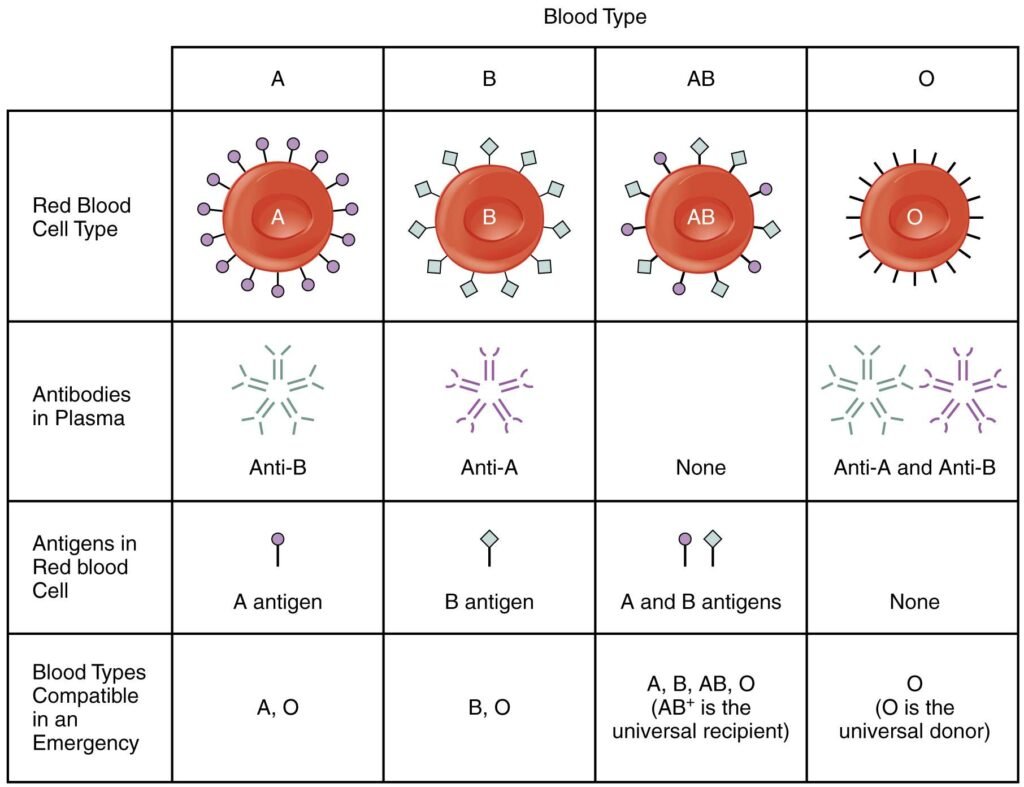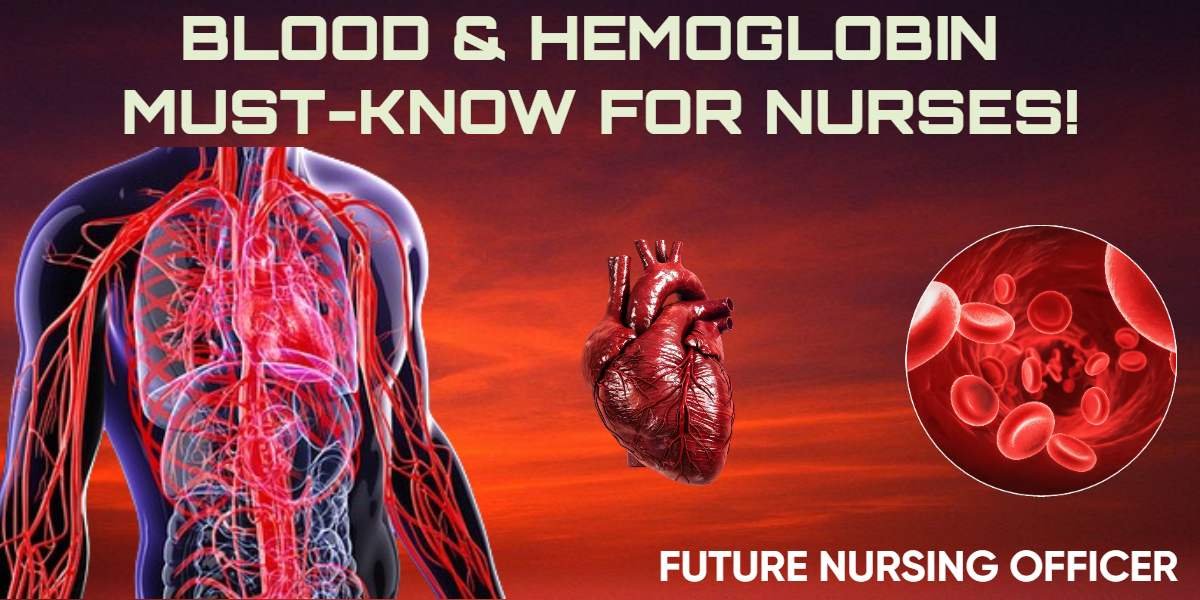Blood – Complete Study Notes for Nursing Exams: Blood is a vital fluid connective tissue that plays a crucial role in transporting oxygen, nutrients, hormones, and waste products throughout the human body. Understanding its composition, function, and components like hemoglobin and hematopoiesis is essential for nursing students and aspirants preparing for competitive exams.

Blood – Complete Study Notes for Nursing Exams
What is Blood?
- Blood is a liquid connective tissue responsible for delivering essential nutrients and oxygen to tissues and removing carbon dioxide and metabolic wastes.
- Its red color is due to the presence of hemoglobin (Hb) in red blood cells.
- It comprises RBCs, WBCs, platelets, and plasma.
Blood is a liquid connective tissue that transports nutrients, oxygen, and waste products between the body’s organs and tissues.
It appears red due to the presence of hemoglobin.
Normal blood volume:
- Males: 5–6 liters
- Females: 4.5–5.5 liters
The normal blood pH ranges between 7.35 to 7.45.
All blood cells (RBCs, WBCs, platelets) are generated in the bone marrow, particularly in long bones in adults.
Site of Hematopoiesis
| Age Group | Site of Hematopoiesis |
|---|---|
| Fetus (0–2 months) | Yolk sac |
| Fetus (2–7 months) | Liver, spleen |
| Fetus (>7 months) | Bone marrow |
| Adults | Bone marrow of ribs, vertebrae, sternum, sacrum, pelvis, proximal ends of femur |
Hemoglobin
- Hemoglobin (Hb) is an iron-containing protein responsible for oxygen transport in RBCs.
- Structure:
- Made of globin (protein with 4 polypeptide chains: 2 alpha + 2 non-alpha).
- Contains heme (iron), which converts to bilirubin for excretion.
Normal levels:
- Males: 13–18 g/dL or 135–180 g/mL
- Females: 12–16 g/dL or 120–150 g/mL
Types of Hemoglobin
| Type | Polypeptide Chains | Remarks |
|---|---|---|
| HbA (Adult) | 2 alpha, 2 beta (α₂β₂) | >95%, normal adult Hb |
| HbA2 | 2 alpha, 2 delta (α₂δ₂) | ~2–3%, normal adult Hb |
| HbF (Fetal) | 2 alpha, 2 gamma (α₂γ₂) | ~3%, normal fetal Hb |
| Gower 1 & 2, Portland | Various | Found only in embryonic period |
Additional Notes:
- HbF has higher oxygen affinity than HbA, aiding oxygen transfer from mother to fetus.
- HbA1c: Glucose-bound Hb, used for monitoring blood glucose over 90 days (important in diabetes).
Hemoglobin Derivatives
- Oxyhemoglobin: Hb + O₂ → Bright red
- Carbaminohemoglobin: Hb + CO₂ → Dark red
- Carboxyhemoglobin: Hb + CO → Toxic form, interferes with O₂ transport
Hematocrit (HCT)
- Indicates the percentage of RBCs in total blood volume.
- Varies based on age, sex, and ethnicity.
Normal Ranges:
- Males: 41%–50%
- Females: 36%–44% (slightly lower)
Clinical Relevance:
- Low HCT: Suggests anemia due to reduced RBCs.
- High HCT: May occur in dehydration or polycythemia (excess RBCs).
Composition of Blood
- Blood constitutes 55% plasma and 45% blood cells.
- Plasma is the liquid part of the blood which consists of 92% water, 8% proteins, and other electrolytes, hormones, and nutrients.
- Albumin (60-65%): Maintains the body’s colloid osmotic or oncotic pressure.
- Globulin (35%): Helps in maintaining immunity of the body and is a type of immunoglobulin (Ig).
- Fibrinogen (4%): Necessary for blood clot formation.

Blood Cells
Red Blood Cells (RBCs):
- Also known as erythrocytes.
- Normal value: 4.5 to 6.2 million/mcl in males and 4.2 to 5.5 million/mcl in females.
- Formed in bone marrow of long bones such as sternum, ribs, iliac crest, femur, and clavicle.
- Process of formation: Erythropoiesis takes 7 to 9 days in bone marrow.
- Decrease in the number of RBCs is called erythrocytopenia or erythropenia.
White Blood Cells (WBCs):
- Also known as leukocytes.
- Two types:
- Granulocytes: Includes neutrophils, eosinophils, and basophils.
- Agranulocytes: Includes monocytes or macrophages and lymphocytes (T-Cell & B-Cell).
- Normal value of WBCs: 4000 to 11000 cells/mm³.
- WBCs are produced in bone marrow and spleen.
Platelets:
- Also known as thrombocytes.
- The smallest cells of the blood (2-4 µm in diameter).
- Normal platelet count: 1,50,000–4,00,000 per microliter of blood.
- Platelets function in blood clot formation to prevent bleeding.
Blood Components Summary
| Parameter | Normal Value |
|---|---|
| Red Blood Cells (RBCs) | Males: 4.5-6.2 million/mm³ Females: 4.2-5.5 million/mm³ |
| White Blood Cells (WBCs) | 4500–11,000/mm³ |
| Platelets | 1,50,000–4,00,000/mm³ |
| Hemoglobin | Males: 13-16 g/dL Females: 12-16 g/dL |
| Hematocrit | Males: 41-50% Females: 36%-44% |
Neutrophils and Macrophages:
- These are immune cells responsible for phagocytosis, meaning they ingest and destroy harmful microorganisms.
- Neutrophils are the first responders to infections and their lifespan is 5-7 days.
- Macrophages are involved in the long-term defense and tissue repair.
Hemoglobin Types
| Type of Hemoglobin | Polypeptide Chains | Remarks |
|---|---|---|
| Hemoglobin A (HbA) | 2 alpha, 2 beta (α₂β₂) | Normal adult Hb |
| Hemoglobin A2 (HbA2) | 2 alpha, 2 delta (α₂δ₂) | Normal adult Hb |
| Fetal Hb (HbF) | 2 alpha, 2 gamma (α₂γ₂) | Normal fetal Hb |
- HbA1c is the glycosylated form of HbA, used to monitor blood glucose levels in diabetic patients.
Human Blood Clotting
Stages of Blood Clotting
- Vasoconstriction: Also called vascular spasm, this is the narrowing of blood vessels to prevent excessive bleeding.
- Platelets Plug Formation Stage: Platelets adhere to damaged endothelium to form a platelet plug (primary hemostasis). This process is activated by a glycoprotein or Von Willebrand factor.
- Blood Coagulation Phase:
- Extrinsic clotting mechanism: Processed by damaged tissues.
- Intrinsic clotting mechanism: Processed by release of chemicals/clotting factors.
Blood Clotting Factors
| Factor | Name | Nature | Source | Pathway & Functions |
|---|---|---|---|---|
| I | Fibrinogen | Plasma Protein | Liver | Common pathway, converted to fibrin (insoluble vehicle of clotting) |
| II | Prothrombin | Plasma Protein | Liver | Common pathway, converted to thrombin (converts fibrinogen to fibrin) |
| III | Tissue factor (TF) | Plasma membrane glycoprotein | Tissue cells | Activates extrinsic pathway |
| IV | Calcium (Ca²⁺) | Inorganic ion | Plasma | Needed for essential stages of coagulation process, always present |
| V | Proaccelerin | Plasma protein | Liver, platelets | Common pathway |
| VI | Proconvertin | Plasma protein | Liver | Both extrinsic and intrinsic pathways |
| VII | Antihemophilic factor (AHF) | Plasma protein | Liver, lung capillaries | Intrinsic pathway, deficiency results in hemophilia A |
| VIII | Plasma thromboplastin component (PTC) | Plasma protein | Liver, lung capillaries | Intrinsic pathway, deficiency results in hemophilia B |
| IX | Stuart factor | Plasma Protein | Liver | Common pathway |
| X | Plasma thromboplastin antecedent (PTA) | Plasma Protein | Liver | Intrinsic pathway, deficiency results in hemophilia C |
| XI | Hemophilic factor | Plasma Protein | Liver | Intrinsic pathway, initiates clotting in vitro, activation initiates inflammation |
| XII | Fibrin stabilizing factor (FSF) | Plasma protein | Liver, bone marrow | Cross-links fibrin, forming a stable clot |
Trick for Remembering the Blood Clotting Factors
- Freshers Party Tonight, Come Lets Sing And Call Seniors Please Have Fun.
Important Points to Remember
- Vitamin K and Calcium must be present in the blood for liver to produce prothrombin.
- Factor number VII, IX, and X are Vitamin K dependent (important for normal coagulation).
- End product of blood coagulation process or hemostasis is Fibrin.
- Plasmin is formed by Plasminogen, and the endothelium formed then fibrin is destroyed by plasmin.
Blood Groups
- A, B, AB, and O blood groups were discovered by Karl Landsteiner in 1901.
- ABO blood grouping system is based on antigens and antibodies present in RBCs.
- The associated anti-A and anti-B antibodies are usually IgM antibodies.
Should Remember
- Rh Factor is also known as Rhesus Factor and was discovered by Karl Landsteiner in 1937.
- According to Rh factor system, persons who have Rh positive are known as Rh+, while those who do not have this factor are known as Rh-.
Tags
Blood cell composition notes for nursing students, Normal RBC and WBC count with clinical significance, Types of white blood cells and their functions, Role of platelets in hemostasis and clotting, Plasma proteins and their functions in blood, Blood component chart for nursing exam, Hematopoiesis process in adults and fetus, Thrombocytopenia causes and clinical levels, Blood coagulation steps in nursing physiology, Nursing notes on blood cells with normal ranges
Blood cell composition notes for nursing students, Normal RBC and WBC count with clinical significance, Types of white blood cells and their functions, Role of platelets in hemostasis and clotting, Plasma proteins and their functions in blood, Blood component chart for nursing exam, Hematopoiesis process in adults and fetus, Thrombocytopenia causes and clinical levels, Blood coagulation steps in nursing physiology, Nursing notes on blood cells with normal ranges
Blood – Complete Study Notes for Nursing Exams, Blood – Complete Study Notes for Nursing Exams, Blood – Complete Study Notes for Nursing Exams

